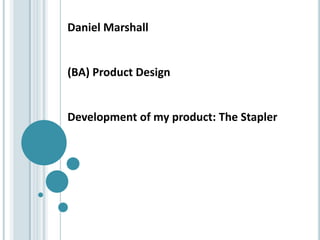
Individual presentation
- 1. Daniel Marshall (BA) Product Design Development of my product: The Stapler
- 2. The shape and form of ideas: The purpose of producing a series of shapes and formations was to help me to transform them into concepts.
- 3. Concept Development – Page 1: The next few pages feature my concepts designs, drawings and models. I will then evaluate and select one.
- 4. Concept Development – Page 2:
- 5. Concept Development – Page 3: A lot of my ideas involved me referring back to the existing product, and focusing on its function.
- 6. Concept Development – Page 4:
- 7. Concept Development – Page 5:
- 8. Matrix evaluation of ideas: Product Functions 1 2 3 4 5 Few Parts ++ ++ ++ - ++ Few Materials + ++ ++ + ++ Disassembly ++ + ++ - ++ D.F.A. ++ + ++ O ++ No. Consumables + + + + + Comfort ++ O ++ O O Performance + O ++ + ++ Aesthetics + + + ++ ++ Size ++ O + ++ O Unique shape and form + O + ++ + TOTAL 15/20 8/20 16/20 8/20 14/20 Number 3 is my selected concept, purely because its simplistic, easy to use and can be improved even greater to meet its target market user.
- 9. Embodiment Design – Prototype Development: Looking more into my selected concept, I have produced models and prototypes to see how it will work, how it looks and how it will reflect upon my market. I initially looked at ribs alone for support, but as shown even in the model, it isn’t strong enough. The design illustrates how the ribs would support the sides. Ribs AND bosses would be an appropriate solution. Injected pins in the top layer would slide into place and hold the structure firmly, with the ribbed walls distributing the weight of the impact from human interaction.
- 10. Embodiment Design – Prototype Development: Mechanisms: The prototype would be held together with the use of the injected pins inside the bosses. The key element to ensure the product is held together and easily assessable is with the use of sliding clips. Once clip is pressed simply open the shell to expose the interior.
- 11. Embodiment Design – Prototype Development: Button: The initial product had 13 parts. I aim to half that at least. The button can be reduced to 4 simple components. To make this more efficient, the cutter will be made longer to hold more paper together.
- 12. Embodiment Design – Prototype Development: Modelling: Understanding how the product will work practically, I now need to look at the aesthetics of my stapler. Stage 1: Stage 2: Stage 3: Stage 4: Stage 5:
- 13. Embodiment Design – Prototype Development: Positives: • Strong structure. • Comfortable to hold. Negatives: • Very bulky. • Too much material use. Model 2: Positives: • Neater body design. • Comfortable to grip. • Doesn’t take too much room. Negatives: • Large, unattractive button exposed. Model 1:
- 14. Embodiment Design – Prototype Development: Positives: • Ideal proportions, both button and body. • Comfortable. Negatives: • Sharp end. • Slightly too small for some users. Model 4: Positives: • Designed more ergonomically. • Comfortable to use. Negatives: • Unusual shape, could be improved. Model 3:
- 15. Embodiment Design – Prototype Development: Positives: • Good design; comfortable, ergonomic and suitable design wise. • Features the staplless function inside and is easier to handle the product. Negatives: • Opening the product may be difficult, so the products interior hinge might have to be removed and instead another sliding clip; this however increases the product parts by one, but the product is still only 6 parts. Model 5:
- 16. Embodiment Design – Target Market Evaluation: The Final product Positives Negatives Amendments • I like the product, Its very comfortable to hold. • It looks really good style wise. • I like the idea of the product and how I can use it to reduce the use of staples. • Staples and other related items such as a stapler remover are no longer necessary. • It can only stitch a specific number of pieces of paper together. • May not be as strong as a staple for holding documents. • The idea of sliding clips could make the final look of the idea less appealing. • The end of the stapler could potentially be harmful with its point. • Ensure the end of the stapler is safe. • The back of the design could also touch the table surface instead of floating. • Ensure the button doesn’t catch fingers if pressed inside; looks as if it could. • Make sure its lightweight. Upon selecting the final and most suited design concept, I referred back to my client to have a one-on-one about it.
- 17. Embodiment Design – Amending the concept: I have made adjustments to the design as shown: • Rounder base. • Grooves for comfort when holding. • The location of the sliding clips; hidden and will be small. Grooves designed Clips located in the curves nearer the button component
- 18. Final Illustration of Product:
- 19. Functionality of product: Here is the process of how the button neatly cuts and stitches the paper.
- 20. Exploded View of Product: Number Name Material Process Quantity 1 Button Nylon Gas assisted injection moulding 1 2 Cutter Steel Metal Injection Moulding 1 3 Spring Spring steel Spring coiling 1 4 Screw Nickel plated steel Heading, threading and coating 1 5 Upper body Nylon Gas assisted injection moulding 1 6 Bottom body Nylon Gas assisted injection moulding 1 Bill Of Materials, (B.O.M.): 1. 2. 3. 5. 6. 4.
- 21. Photo’s of the Final Presentation Model:
- 22. Thank you for listening!